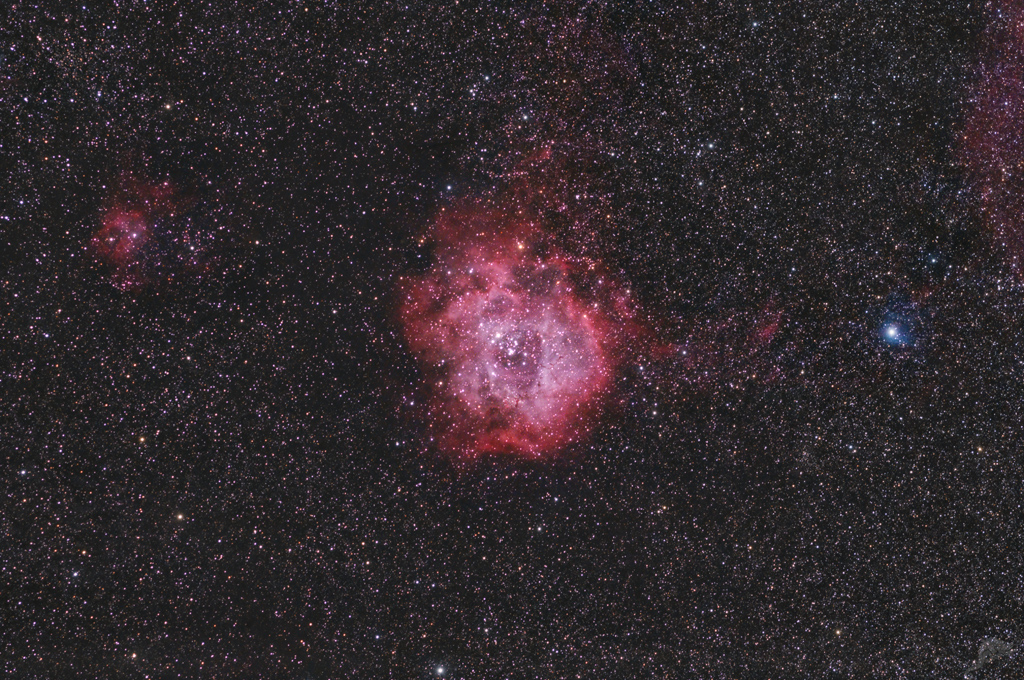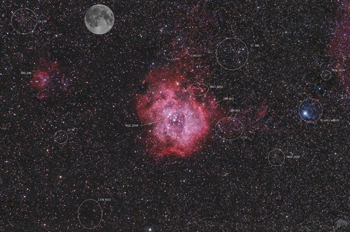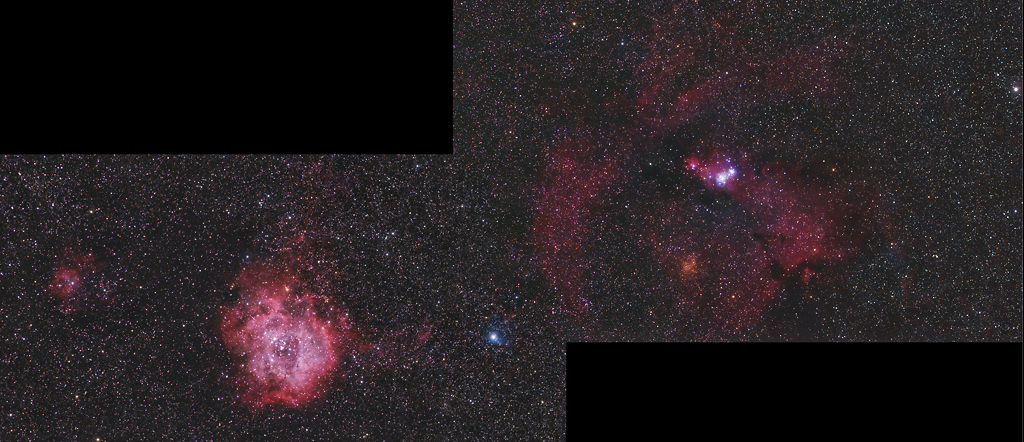 |
CHAMÄLEON + ONJALA OBSERVATORY DeepSky | SITEMAP HOME CHAMÄLEON |
|
 |
|||
| « back to overview Nebulae | Load higher resolution (1800 x 1200 Pixel 3500 x 2300 Pixel) | Object description |
A widefield mosaic of Rosette nebula and the H-II region around NGC NGC 2264 is shown here

The Rosette Nebula in the constellation Unicorn The Rosette Nebula is a large H-II star forming region in the constellation Unicorn. It lies pretty much in the direction of the galactic equator, so the whole region is rich in open star clusters, glowing nebulae and dark clouds. The Rosette Nebula is almost circular with an apparent diameter of 80 x 60 arcminutes (about 140 light years). In the center of the H-II region lies the open star cluster NGC 2244, which is about 5200 light years away from the solar system. The region belongs to the star association Monoceros OB2.
The nebula itself has several entries in the NGC catalogue, according to the first observations of different astronomers. They are NGC 2237 (observation of Lewis A. Swift from 1865), NGC 2238 (observation of Albert Marth from 28 February 1864), NGC 2239 (observation of John Herschel from March 1830) and NGC 2246 (observation of Lewis A. Swift from 27 February 1886). The open star cluster in the center of the H-II region has a double entry with NGC 2239 (observation of John Flamsteed on February 17, 1690) and NGC 2244 (observation of John Flamsteed on February 17, 1690).
South of the Rosette Nebula (left in the image) is another H II region, Sh2-280, which in the labeled version of our image with LBN 941, 943 and 951 are the brightest parts of an old supernova remnant. In the large, open star cluster Collinder 106 the position of Plaketts star and the variable star 12 Mon is also marked.
NGC 2244/NGC 2239
The inner core of the Rosette Nebula is nearly free of dust and gas and here are the bright stars of NGC 2244, about 10 hot blue stars of spectral types O5 to B1, which are formed from the gas of the core. They are very young stars with an age of only a few million years. These stars ionize the hydrogen gas of the Rosette Nebula and make it glow. At the same time, the radiation pressure and violent stellar winds typical of young stars push the surrounding matter outward. As a result, the Rosette Nebula expands and is additionally compressed at its inner rim. Altogether the star cluster contains about 100 stars.
The brightest star in NGC 2244, the variable 12 Mon, is an old, yellow shining K0 giant star. It does not belong to the star cluster, it is a foreground star, already detected in 1962 in a photometric survey by H. Johnson.
 |
« Labeled version with object names and a size comparison to
the moon Plaskett's star, also catalogued as HR 2422 and V 640 Monocerotis, is a spectroscopic double star consisting of 2 blue supergiants at a distance of about 6600 light years. It is one of the most massive double star systems known, with a total mass that is about one hundred times larger than that of our Sun. It was long thought to be the most massive double star system known, but scientific studies carried out between 1996 and 2005 showed that Eta Carinae, previously thought to be a massive single star, is a double star system much more massive than V 640 Mon. This double star system is named after John Stanley Plaskett, a Canadian astronomer who discovered binary nature in 1922. The orbital period of the companion star is given as 14.4 days, and the companion star (V 640 B), because it rotates very fast, is likely to be flattened out clearly equatorially. Because of the small distance of only 0.5 AU between V 640 A and B, an exchange of matter between the two stars is likely. The published data for V 640 A and B are: |

 |
 |
 |
 |
 |
 |
 |
| Sun | Moon | Solar System | DeepSky | Widefield | Miscellaneous | Spec. Projects |